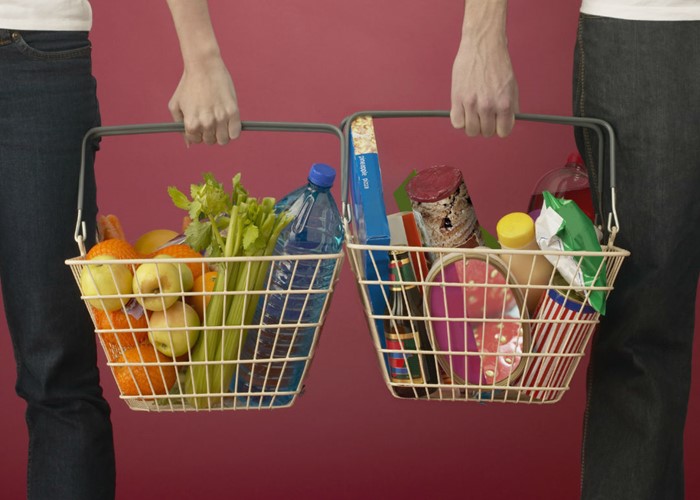
The prices of budget and own-brand products have grown at a faster rate than branded and premium goods, new study suggests.
If you’re trying to cut the cost of your supermarket shopping by focusing on budget and own-brand ranges, then it might not be quite the cost-cutting step you hope for.
A new study from consumer champions Which? has revealed that the prices of supermarket own-brand and budget ranges have increased by more than the costs of premium and branded foods in recent months, in some cases by up to 175%.
Which? tracked the price changes of thousands of food and drink products at eight big supermarkets: Aldi, Asda, Lidl, Morrisons, Ocado, Sainsbury’s, Tesco and Waitrose.
It found that on average the price of budget items have grown by 18% year-on-year, compared with 13% increases for premium own-brand goods and 12% for branded foods.
Some increases to individual items were really significant.
For example, when looking at supermarket budget ranges, the cost of Creamfields soft cheese at Tesco rose from 49p to 84p, a jump of 72%, while Sainsbury’s Simply Muesli went to £2.03 from £1.20, an increase of 70%.
However, it was on the mid-priced own-brand products that the largest hikes took place.
At Waitrose for example, the cost of 200g chocolate chip shortbread almost tripled, from 82p to £2.25, a growth of 175%.
This was followed by the 132% rise on the cost of Asda’s chilli con carne ready meal, growing in cost from £1.20 to £2.79.
The worst supermarkets for price increases
Strikingly, the supermarkets that have seen the biggest price inflation on all food and drink products year on year, according to Which?, were Aldi and Lidl.
Prices at Aldi grew by an average of 19.6%, while at Lidl they increased by 19%. This compares with Asda (15.2%), Morrisons, (14.4%), Waitrose (14.2%), Sainsbury’s (13.7%) and Tesco (12.6%). The lowest level of inflation was seen at Ocado, with just 10.3%.
However, it’s worth bearing in mind that even with these price rises, the deep discounters are still a fair bit cheaper than their rivals.
Which? publishes a monthly tracker monitoring how the cost of a typical basket of goods varies across the main supermarkets, and here’s how they shaped up in November.
|
Supermarket |
Basket cost |
|
Aldi |
£77.21 |
|
Lidl |
£78.57 |
|
Tesco |
£87.60 |
|
Asda |
£87.66 |
|
Sainsbury’s |
£89.85 |
|
Morrisons |
£93.49 |
|
Ocado |
£96.09 |
|
Waitrose |
£104.11 |
Fighting food price inflation
The rising cost of food is never a positive thing, but it’s even more painful at the moment given the state of our finances.
Our finances are under incredible pressure, seemingly from every angle.
In every area of our lives, we are having to cough up more and more money, without necessarily seeing our incomes increase.
And it’s on those essential products that price rises are most severe. It’s one thing to dump your Netflix subscription when times are tough, but it’s not like you can simply stop buying food because money is tight.
Given food price inflation is currently at an eye-watering 16.2% according to the Office for National Statistics, that’s big price rises that we have little option but to absorb.
Shopping smarter
In normal times, when the cost of heading to the supermarket is rising, then there are certain simple things you might do.
Chief among them would likely be dropping some of the premium brands, and moving to a supermarket’s own brand instead.
That’s not going to be as effective a tactic if supermarkets are hiking the prices of those goods even more quickly than they are raising prices on everything else, however.
Instead it may mean a more drastic move, switching the supermarket you use entirely.
And the evidence suggests that an awful lot of us are doing that already, moving to a rival retailer which may deliver better value for money.
The data from KantarWorldPanel on supermarket market share shows that since last Christmas Tesco has seen its market share drop from 27.9% to 26.9%, while Sainsbury’s share has fallen to 14.8% from 15.7%.
Asda, Morrisons and Waitrose have all seen their share drop too.
By contrast, the share of Aldi has moved from 7.7% to 9.1%, while Lidl’s has grown from 6.3% to 7%. Co-op’s has risen too, from 5.8% to 6.5%.
That’s a pretty clear message that shoppers are already voting with their feet, and electing to do their shopping at stores which allow them to stretch their money the furthest. That’s only likely to continue for as long as food inflation is at such elevated levels.
Of course, switching supermarket isn’t the only way to cut the cost of your food shopping. You can also make use of loyalty schemes to get a better return on the money spent, and utilising shopping lists.
Check out our run-through of the best ways to cut your grocery spend.